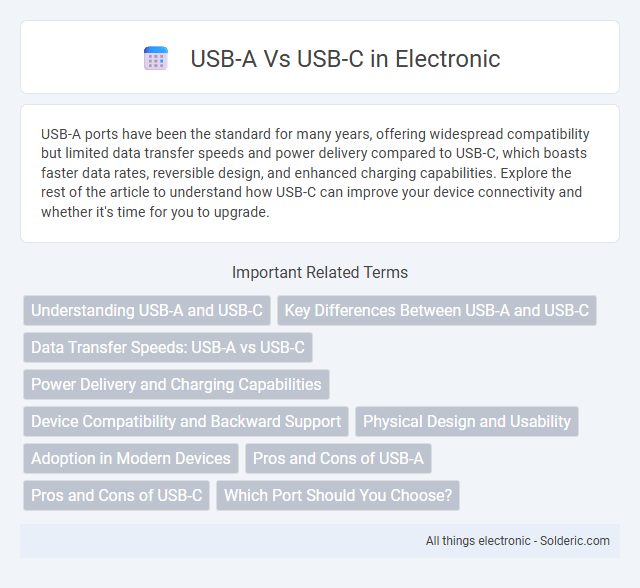USB-A ports have been the standard for many years, offering widespread compatibility but limited data transfer speeds and power delivery compared to USB-C, which boasts faster data rates, reversible design, and enhanced charging capabilities. Explore the rest of the article to understand how USB-C can improve your device connectivity and whether it's time for you to upgrade.
Comparison Table
| Feature | USB-A | USB-C |
|---|---|---|
| Connector Shape | Rectangular, single-sided | Oval, reversible |
| Data Transfer Speed | Up to 10 Gbps (USB 3.1 Gen 2) | Up to 40 Gbps (Thunderbolt 3/4) |
| Power Delivery | Up to 2.5W (USB 2.0) to 100W (USB PD via adapters) | Up to 100W (USB Power Delivery native) |
| Compatibility | Widely compatible with older devices | Increasingly standard, backwards compatible with adapters |
| Orientation | One-way plug | Reversible plug |
| Video Support | No native support | Supports video output (DisplayPort, HDMI alternate modes) |
| Usage | Common on peripherals like keyboards, mice, flash drives | Used in modern smartphones, laptops, peripherals |
Understanding USB-A and USB-C
USB-A and USB-C are two prevalent USB connector types with distinct designs and functionalities. USB-A features a rectangular shape and is widely used for data transfer and charging in older devices, supporting USB 2.0, 3.0, and 3.1 standards. USB-C offers a smaller, reversible connector with enhanced capabilities, including faster data transfer rates up to 40 Gbps via Thunderbolt 3, higher power delivery up to 100W, and broader compatibility with modern devices like smartphones, laptops, and peripherals.
Key Differences Between USB-A and USB-C
USB-A features a rectangular design and supports lower data transfer speeds compared to USB-C's smaller, reversible connector with faster USB 3.1 and Thunderbolt 3 compatibility. USB-C delivers higher power output for rapid device charging and supports video output through protocols like DisplayPort or HDMI Alt Mode. Understanding these key differences helps you choose the right cable for enhanced connectivity and performance.
Data Transfer Speeds: USB-A vs USB-C
USB-C supports faster data transfer speeds with USB 3.2 Gen 2x2 reaching up to 20 Gbps, while USB-A typically maxes out at USB 3.2 Gen 1 speeds of 5 Gbps. The USB-C interface also enables Thunderbolt 3 and 4 protocols, pushing transfers up to 40 Gbps, significantly outperforming the older USB-A standard. This makes USB-C ideal for high-speed data tasks like 4K video editing and large file transfers compared to USB-A.
Power Delivery and Charging Capabilities
USB-C significantly outperforms USB-A in Power Delivery, supporting up to 100 watts of power transfer, enabling faster and more efficient charging for devices like laptops, smartphones, and tablets. USB-A typically offers lower power output, maxing around 2.5 watts to 4.5 watts, which limits its ability to charge high-power devices quickly. The USB Power Delivery (USB PD) protocol, exclusive to USB-C, dynamically adjusts voltage and current to optimize charging speed and safety, making it the preferred choice for modern electronics.
Device Compatibility and Backward Support
USB-A ports remain widely compatible with older devices, supporting a vast range of peripherals such as keyboards, mice, and external drives. USB-C offers enhanced compatibility with modern devices, including smartphones, laptops, and tablets, supporting faster data transfer and power delivery standards. Both USB standards maintain backward compatibility through adapters or cables, ensuring seamless integration across different device generations.
Physical Design and Usability
USB-A features a rectangular, flat design with a single orientation, often requiring users to align the connector correctly before insertion, which can lead to occasional frustration. USB-C offers a smaller, reversible design that allows easy plug-in from either side, greatly enhancing user convenience and reducing wear on ports from repeated attempts. The compact and symmetrical form of USB-C supports slimmer devices while improving overall durability and user experience compared to the bulkier USB-A connectors.
Adoption in Modern Devices
USB-C has rapidly become the dominant standard in modern devices due to its reversible design, faster data transfer rates up to 40 Gbps with Thunderbolt 3 support, and ability to deliver up to 100 watts of power for charging. USB-A remains prevalent in legacy and budget devices, primarily because of its widespread compatibility and extensive existing infrastructure. Major smartphone manufacturers, laptops, and tablets increasingly favor USB-C to support power delivery, video output, and universal connectivity, accelerating USB-C adoption across consumer electronics.
Pros and Cons of USB-A
USB-A offers widespread compatibility with many legacy devices and accessories, making it a reliable choice for connecting older peripherals. Its larger connector size provides durability but limits its reversibility, causing occasional frustration during insertion. You may find USB-A slower in data transfer speeds and less versatile compared to USB-C, especially as USB-C supports faster charging and more advanced protocols.
Pros and Cons of USB-C
USB-C offers faster data transfer speeds up to 40 Gbps with Thunderbolt 3 support and delivers higher power output up to 100W for efficient device charging, making it ideal for modern laptops and smartphones. Its reversible design enhances user convenience by eliminating plug orientation errors, while its compact size supports thinner and lighter device designs. However, USB-C adoption varies, leading to compatibility issues and the need for adapters, and not all USB-C cables support maximum speed or power, causing potential confusion for users.
Which Port Should You Choose?
USB-C offers faster data transfer speeds up to 10 Gbps and supports power delivery up to 100W, making it ideal for charging laptops and transferring large files efficiently. USB-A remains widely compatible with older devices and peripherals, providing reliable connectivity for everyday use. Choose USB-C if your priority is future-proofing and versatility, while USB-A suits your needs if you rely on legacy hardware.
USB-A vs USB-C Infographic

 solderic.com
solderic.com